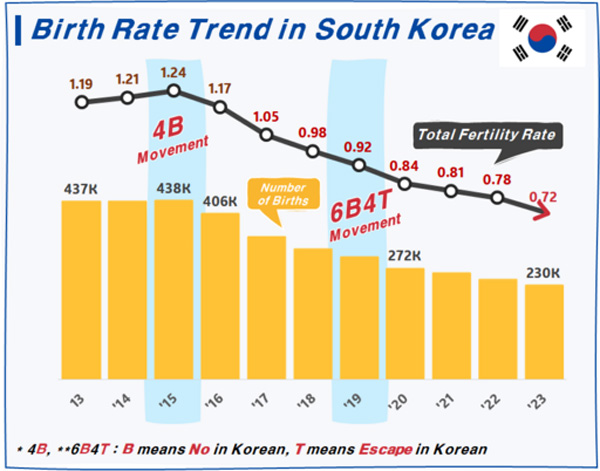Nations are facing a population decline

[Birth rate trend in South Korea. Photo Credit to Wikimedia Commons]
Korea, which recorded the lowest recorded birth rate globally at 0.84 in 2020, exemplifies a global crisis as countries worldwide experience declining birth rates that threaten economic stability and cultural continuity.
According to demographic data, the global birth rate has dropped dramatically from 5.0% in the 1960s to 2.3% in 2020, declining through 3.7% in the 1980s and 3.0% in the 1990s.
The UN Population Division states that, for a country to maintain a healthy population and economy, the birth rate should remain at approximately 2.1%, a figure that can vary depending on the country’s mortality rates and other demographic factors.
Contemporary cultural shifts, including an increase in female education and increasingly competitive work environments, explain why many families choose to have few or no children.
In recent decades women have achieved greater equality and educational opportunities.
This often leads them to prioritize professional development and financial independence, causing them to marry later and have children later, or forgo children entirely.
Moreover, intense work culture leads adults to frequently work long hours, discouraging marriage or childbearing.
Korean parents, like other East Asian parents, place pressure on their children in Korea’s highly competitive society, pressuring their children to excel academically.
Even if Korea could achieve a steady 2.1 birth rate in coming years, the country would still face economic challenges due to uneven population distribution across age groups.
Korea isn’t the only country facing declining birth rates.
Nations including the United States, China, and others are all experiencing similar declines.
The phenomenon can be described as a distant noise that many ignore, only to realize its impact when it affects humanity directly.
With fewer young adults entering the workforce, countries face challenges sustaining economic growth and maintaining stable economies.
The decline affects more than economics.
It also impacts the social fabric: younger people studying in empty classrooms, and young adults spending increasing amounts of time alone in their apartments.
Furthermore, cultures transmitted across generations may gradually disappear as fewer young people remain available to learn from elders.
Loneliness and isolation may rise as more elderly people live without children nearby.
Unfortunately, no simple solutions exist for this major challenge, only incremental political changes may provide modest relief.
In a world once afraid of overpopulation, humanity now faces the silence of empty classrooms.
The future will depend not only on numbers, but on how society chooses to address this dilemma.

- Aiden Park / Grade 9 Session 9
- The Stony Brook School

![THE HERALD STUDENT REPORTERS [US]](/assets/images/logo_student_us.png)
![THE HERALD STUDENT REPORTERS [Canada]](/assets/images/logo_student_ca.png)
